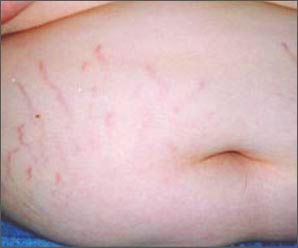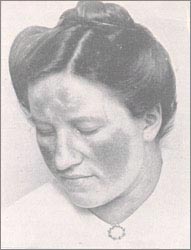



Copyright ⓒ 2014 John Sangwon Lee, MD, FAAP
Skin changes during pregnancy 임신 중 피부의 변화

Stretch marks on the stomach, Stretch marks on the hip
![]()
Most pregnant women gain more weight during pregnancy than usual when they are not pregnant, and when pregnancy reaches full term, it is normal for pregnant women to lose weight of 10 to 13 Kg.
So, the skin of the face, belly, and legs is tightened, and the skin is soft and moisturized, and the skin shines under the influence of hormones
. And the following skin changes can occur in pregnant women
1. Stretch marks can form on the skin of a pregnant woman’s abdomen, breasts, and thighs.
The Stretch marks during pregnancy is pink-red.
It is common to return to white, gray or normal skin color after delivery.
These Stretch marks are caused by the influence of pregnancy hormones in the fibrous tissue in the skin layer. Stretch marks develop in 70% of pregnant women.
There is no way to prevent Stretch marks from occurring, but if you do not become obese by appropriate exercise and food intake during pregnancy, you may develop less kidney plaques.
Most Stretch marks on the skin during pregnancy usually disappear or fade naturally after delivery.
Stretch marks are more likely to occur in pregnant women with less elastic skin, and are more likely to occur in infertility than in prenatal women and are hereditary. And it can be more prone to obese pregnant women.
2. Brown spots (Chloasma) or spots may appear on the face.
Brown spots on cheeks and forehead
There are cells that produce skin pigment on the face.
Under the influence of pregnancy hormones, the cells produce brown, which can cause brown spots on the face.
Brown spots are particularly common on the forehead, cheeks, edge of the eyes, and nose.
It may appear brown in white and fair-skinned pregnant women, and pale brown spots in dark-skinned pregnant women.
It’s common for the brown spots to get darker with more exposure to the sun. It is common for these brown spots to fade or disappear completely after delivery.
3. Black skin line-Linea nigra
Brown skin lines on the stomach During pregnancy, under the influence of hormones, black or brown skin lines can form from the navel to the anterior center of the pubis.
These lines of skin can extend from the navel to the top of the upper abdomen.
It is usually a light color for pregnant women with fine white skin, and a darker black color for pregnant women with dark and dark skin.
4. Acne Acne
If a woman who did not have acne before pregnancy may get acne during pregnancy, acne may occur during pregnancy, and the acne that occurred before pregnancy may be less or disappear during pregnancy.
Acne during pregnancy usually gets better and disappears after 4 months of pregnancy. If you don’t eat a lot of fatty foods and do the physical exercise properly, it’s common to get less acne. It should never be treated with unprescribed medication. 5. Spider angiomas
During pregnancy, in some pregnant women, thin capillary veins that resemble a spider web may appear as red spots on the surface of the skin layer.
If you press it lightly with your finger, the color changes to normal skin color, and when you release the pressed finger, it turns red again.
During pregnancy, the hormone estrogen is secreted more than when you were not pregnant, and it is caused by the influence of that hormone. It usually disappears spontaneously after delivery. There is no need for treatment.
6. Skin flaps
Small skin plates about a few millimeters can form on the elbows, which are usually rubbed well. I don’t know for sure the cause.
It is better to leave it without any treatment and observe it.
7. Itchy hands and feet
During pregnancy, due to the influence of the hormone estrogen, itching symptoms may occur in the palms or soles of the feet, and the hands and soles of the feet may be red. If you have severe itching symptoms, it is better to seek medical help.
Copyright ⓒ 2014 John Sangwon Lee, MD, FAAP
“부모도 반의사가 되어야 한다”-본 사이트의 내용은 여러분들의 의사로부터 얻은 정보와 진료를 대신할 수 없습니다.
“The information contained in this publication should not be used as a substitute for the medical care and advice of your doctor. There may be variations in treatment that your doctor may recommend based on individual facts and circumstances.
“Parental education is the best medicine.“